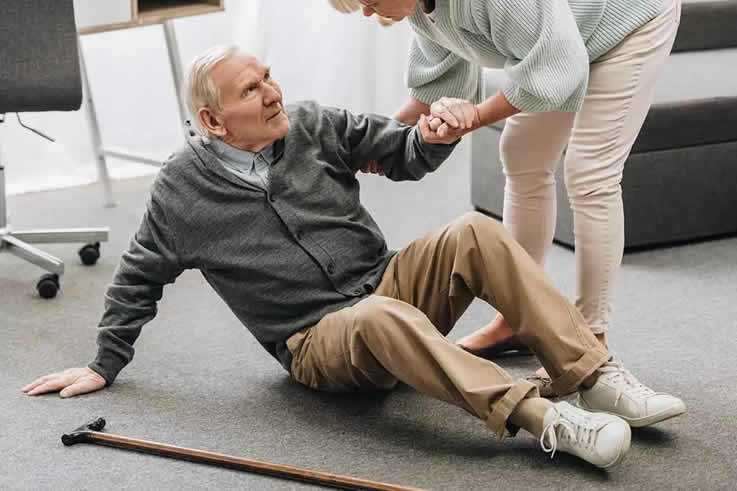By: Marie Serrado
Fall is right around the corner, which means accidents can happen at any time, whether you slip on a rug or experience a fall on a slippery sidewalk. For older adults, these accidents can lead to broken bones, which, in turn, could result in major health problems and disabilities. In this blog post, we will be discussing some fall prevention tips and how one can avoid any future accidents.
What causes older adults to fall?
With seniors, a wide range of situations can lead to fall accidents, including eyesight failure, diabetes, failed reflexes, rushed movements, and more. As we show signs of aging, our bodies undergo various changes that can impact our balance and stability. However, there are ways to take precautions and preventive measures that can help minimize the risk and help seniors maintain their independence and well-being.
How to Prevent Falls?
- Staying Active:
Staying active is not only important as we begin to age, but it is also important to help keep the body moving to prevent falls. Make sure to look for an exercise plan that accommodates your needs and works best for you. Regular exercise helps improve your muscles and makes them stronger. Exercise also helps with keeping your joints, ligaments, and tendons flexible. Doing mild weight-bearing activities like walking, according to the NIA (National Institute of Aging), may slow bone loss from osteoporosis, a disease that makes bones weak and more likely to break. - Balance and Strength Training:
Trying out balance and strength exercises like yoga and Pilates can help with preventing falls. You can also consult your physical therapist to see which balance and strength training exercises you could do to help build strength. Your physical therapist can also help identify the problem and get you moving better and more confidently. Physical therapists can even help assess your balance, strength, and walking. - Fool Proof your home:
Fall accidents don’t just happen outside, they can even occur at your very own home. According to the NCOA ( National Council on Aging), the majority (60%) of falls occur at home, while 30% occur in a public setting. Some ways you can fool proof your home is by:- Securing handrails on both sides of the stairs: when you are holding onto the handrails make sure you have a secure grip on them, and make sure no one is blocking your view of the steps.
- Lighting: Make sure there is good lighting in the home, consider using motion activated lights, so that way it can turn on automatically when you move.
- Clean up walk-way: Ensure that your walkway or even passages are clean and tidy, to prevent slips or trips.
- In the bathroom, mount bars outside and inside of the shower and tub, and mount a bar near the toilet.
- Place non-skid mats or carpets onto wet surfaces.
- In case of fall, make sure you have a phone at reach in order to contact 911.
- Find out the side effects of any medicine you may be taking
It’s important to understand the medications you may be taking; some medicines have side effects that can cause dizziness and affect sleep. Make sure you tell your doctor and pharmacist about those side effects.
- Using assistive devices to help with walking
Using assistive devices can help prevent falls with older adults. If your doctor recommends using a cane or walker, ensure that it’s the right size for you. It’s exceptionally important when there are uneven sidewalks and walkways that you have that walker or cane with you. Also, ask your physical or occupational therapist, as they can help you decide which devices might be helpful and teach you how to use them safely.
- Choosing the right footwear.
Wearing the right footwear can help prevent slips and falls that can cause injury to older adults. To fully support your footing, make sure to wear non-skid, low-toed, rubber-soled, closed-toed shoes. Do not walk around the house in socks or walk up the stairs with socks as this can also cause slips. Also, make sure not to wear shoes and slippers that have smooth soles.
Conclusion:
In conclusion: as the fall season approaches, it is essential to be proactive in preventing accidents, especially for older adults who are more vulnerable to fall-related injuries. By following some simple fall prevention tips, we can significantly reduce the risk of accidents and their potential consequences. By incorporating these fall prevention strategies into daily life, older adults can reduce the risk of falling and minimize the potential for broken bones and other health complications. Remember, being proactive and taking preventative measures is the best approach to enjoying a safe and injury-free fall season. Stay vigilant, stay active, and prioritize your safety to make the most of this beautiful time of year.
References:
- “Get the Facts on Falls Prevention.” The National Council on Aging, ncoa.org/article/get-the-facts-on-falls-prevention. Accessed 2 Aug. 2023.
- “How a Physical Therapist Can Help You Reduce Your Risk of Falling.” The National Council on Aging, ncoa.org/article/how-a-physical-therapist-can-help-you-reduce-your-risk-of-falling. Accessed 2 Aug. 2023.
- “Preventing Falls at Home: Room by Room.” National Institute on Aging, www.nia.nih.gov/health/preventing-falls-home-room-room. Accessed 2 Aug. 2023.



